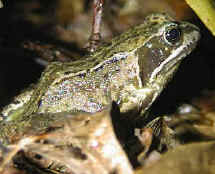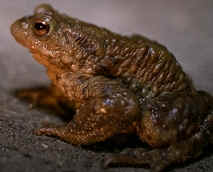What are Toads?
Lifespan - Breeding Sites - Tadpoles - Sound - AVI's - Frog or toad?

Toads are amphibians.
There are two kinds of toads native to Britain. These are the Common Toad (Bufo bufo) (see left) and the Natterjack Toad (Bufo calamita). The Common Toad, as the name suggests, is widespread throughout Britain, although it does not occur in Ireland.
The Natterjack Toad is found mainly in the coastal dunes of East Anglia and in the North West of England. It was formerly common on southern heathlands. Its numbers are declining and it is now protected by law. The two species can be easily distinguished by the presence of a prominent yellow line down the back of the Natterjack Toad.
Amphibians are a class of animals that have mucous glands in their skin. Their skin has no feathers, scales or hairs. Some of them including the Common Toad have poison glands. Frogs and newts are also amphibians. Amphibians lay their eggs in water where they develop into larvae (tadpoles). Amphibians have to return to water to lay their eggs because the eggs have no shell and therefore no protection against desiccation. In contrast, reptiles and birds have evolved eggs with protective shells, which allow them to lay their eggs on dry land. The tadpoles are aquatic and have gills for breathing in water. They pass through several stages of development, gradually assuming the adult form (a process known as metamorphosis).
The earliest known ‘proto’ frog dates from the Triassic period and is approximately 250 million years old. True frogs were in existence as long ago as the early Jurassic period, predating the appearance of most of the major dinosaur groups.
What is the Difference Between Frogs and Toads?


Common Frog (Rana temporaria) Common Toad (Bufo bufo)
Frogs and toads look superficially quite similar. However, frogs usually have a smooth, moist skin and spend most of their lives in or near water (their moistness makes them susceptible to drying out). They have longer hind legs than toads and characteristically move by leaping. In contrast, toads usually have a dry, warty-looking skin and spend most of their time living on land. Their hind legs are shorter than frogs and they crawl rather than jump.
Toads are fascinating creatures and there is absolutely no truth to the old wives tale that handling them can give you warts! (Viruses give you warts, not toads.) They should of course always be handled with great care to avoid injuring them. You should also always wash your hands afterwards because of the toxins in the toad's skin.
Toads are predators, typically eating insects and small animals such as worms, slugs and snails. Prey is seized with the long sticky tongue, which is rooted at the front of the mouth. This can be extended by as much as 25mm.
Breeding - Toad Watch - Sound - Tadpoles - AVIs